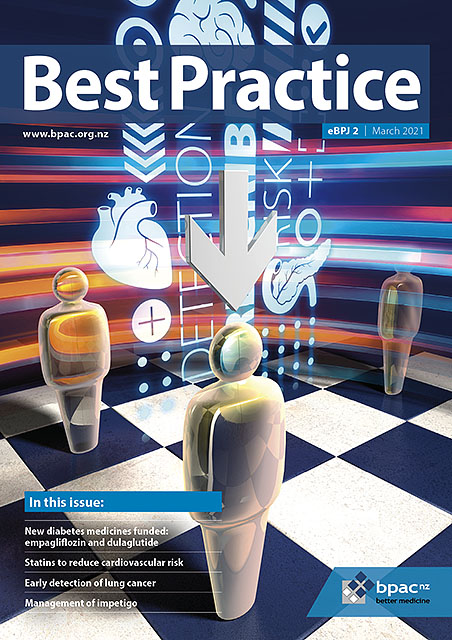 Want to receive Best Practice Bulletin directly to your inbox?
Sign up here.
Want to receive Best Practice Bulletin directly to your inbox?
Sign up here.
Published: 1 April, 2021
Contents
In case you missed it: New eBPJ

|
A new edition of Best Practice Journal is now available online. In this issue we take a closer look at the two
new medicines funded for people with type 2 diabetes, empagliflozin and dulaglutide. We update the evidence on
lipid-lowering treatment, remind about best practice management of impetigo and as part of our ongoing series on
cancer care in New Zealand, we focus on the detection and diagnosis of lung cancer. Also included in this edition
are continuing professional development activities and a sneak peek at upcoming articles.
View eBPJ-2
|
Looking for a printed copy?
We are doing things a little differently this time and asking that anyone interested in receiving a complimentary printed copy of eBPJ2
registers their details. We will then do a random selection for the available copies. This way people don't miss out just because they
didn't happen to check their email in time – last time we "sold out" of our copies in just under six hours! You have until
April
9th to register.
Updated article on ACE inhibitors

|
As reported in Bulletin 21, PHARMAC has announced funding restrictions
for cilazapril. We have revised our
ACE inhibitors article
to reflect these changes, and updated guidance on selecting an appropriate alternative. ARBs are now recommended as a first-line alternative
to ACE inhibitors for many indications and are significantly less likely to cause cough, which may be particularly desirable in the current
environment of the global COVID-19 pandemic.
|
Changes coming for paracetamol labelling
Medsafe has announced it will be introducing new
requirements for the warning and advisory statements on non-prescription products containing
paracetamol, as a result of a public consultation process. The implementation date of changes will be 1 October, 2022 for solid oral dose forms and
suppositories, and 1 April, 2023 for liquid dose forms. It is expected that any medicines released for supply in New Zealand after these dates will
have updated package labels.
The new requirements for warning and advisory statements include:
- Altering the paracetamol liquid dosing table to include two dose volume rounding options, removing the overlap
from the age brackets, and reducing the dose for the 1–2-month age bracket
- Adding the statements “It is mandatory to supply a dosage device with over-the-counter paracetamol products”
and “Always make sure the cap is on this bottle correctly” for liquid paracetamol products
- Adding the statement “Do not crush or chew these tablets” for modified release paracetamol products
- Adding the statement “CONTAINS PARACETAMOL” for all products that do not have paracetamol as part of the
trade name
- Minor rewording of some statements to make them more consumer friendly
Read the full outcome of the consultation on proposed changes to current warning and advisory statements for
paracetamol here.
Keyword search added to bulletins
We have now added an A-Z index to the Best Practice Bulletin homepage so you can search for content using keywords.
Clicking on a keyword will bring up a list of bulletin items that relate to the search term.
Mātauranga Māori: raising awareness of water quality
While outside of the usual type of news we report, we came across a project from ESR that brings together community, health and learning in a very special way.
ESR Māori Impact Scientist Georgia Bell has collaborated with pupils from a local school to create a resource aimed at children about testing for E.coli in rivers.
"He wai ora mahere Mātai i ngā Waikaukau – Is Our Water Safe for Swimming?" raises awareness about safety of drinking water and using local awa (rivers)
for gathering mahinga kai (traditional harvested food) and kau (swimming). Mātauranga Māori is knowledge passed on from ancestors and knowledge
continually being developed by Māori today. It provides us with a Te Ao Māori approach to conventional scientific principles.
Read more about the project
here. The resource is available in Te Reo Māori or English and can be downloaded for free from the ESR
website.
Paper of the week: Don't forget to scan this Easter
A study published in the New
Zealand Medical Journal last week revealed that the majority of people are not scanning COVID Tracer QR codes.
The researchers observed behaviour at 40 hospitality venues, churches and supermarkets in Dunedin over a four-week period in January/February 2021.
Each venue was visited once during peak time, the number of adults entering the venue were counted over an hour, and it was noted how many scanned
the QR code. Data collectors were covert, so as not to draw attention to the study purpose. The median number of people scanning QR codes was 10.2% (range 0 - 50%).
The results of the study may reflect a higher level of complacency towards scanning by people in the South. However, it is a timely reminder
for us all that we must remain committed to our efforts to contain the virus. So, while you are out and about this Easter, make sure your phone is out too...
More results
Half of the cafes, restaurants and bars met all criteria for correct display of the COVID Tracer QR Poster; all supermarkets
and four out of five churches met all display criteria.
- 7/40 venues displayed a cropped or non-A4 poster
- 4/40 venues did not display the poster in a prominent position, including wrong height and obstructed view
- In 12/40 venues no visitors scanned the QR poster during the studied timeframe; eight of these venues were bars
- The median proportion of people scanning by venue was: cafes (21.5%), restaurants (10.2%), bars (0%), churches (4.4%), supermarkets (14.1%)
- The total number of visitors recorded entering the venues was 2886
- The data collectors observed that in many couples, one person scanned on behalf of both people
Data was not collected on the reasons why people were not scanning. The authors speculated that these reasons are most likely to
include: complacency (last COVID-19 cases reported in the Southern DHB were in April, 2020), perception that there is no need to
scan (e.g. no COVID cases and no MIQ facilities in the Southern DHB), no mobile phone or software incompatible with mobile phone (i.e. older model).
Anecdotally, many people say they are not scanning QR codes because it takes too long to locate the app on your
phone. Dr Michelle Dickinson (Nanogirl) has made a short
video explaining how to
set up a “double tap hack” on your iPhone.
Parkin L, Singh A, Seddon E, et al. Audit of NZ COVID Tracer QR poster display and use in Dunedin. NZ Med J 2021;134(1532).
Available from: https://www.nzma.org.nz/journal-articles/audit-of-nz-covid-tracer-qr-poster-display-and-use-in-dunedin-open-access
 This Bulletin is supported by the South Link Education Trust
This Bulletin is supported by the South Link Education Trust
If you have any information you would like us to add to our next bulletin, please email:
editor@bpac.org.nz
© This resource is the subject of copyright which is owned by bpacnz. You may access it, but you may not reproduce it or any part of it except in the limited situations described in the terms of use on our website.





